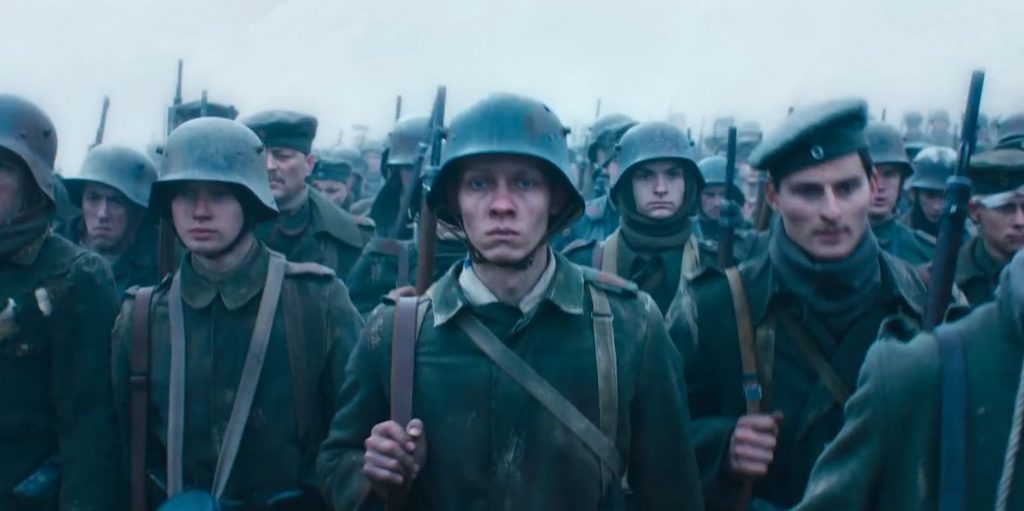How All Quiet on the Western Front (2022) reinvents the anti-war epic


What is an anti-war film?
An anti-war film is defined as a film that exposes the futility of war, and the endless cycle of bloodshed that results from it; some of these films may focus on specific issues surrounding armed conflicts such as the use of biological weapons, or the ways in which war affects the human psyche. What makes these films anti-war is that they take an active role in criticising armed conflicts, through either a dark or gritty imagining of a specific battle, to illustrate the brutal nature of war, or through a slow and sombre script, which focuses on the effects of those involved.
Regardless of what methods a filmmaker may use to convey that message, the product is still a spectacle for those viewing it from the comfort of their homes, or cinemas. Thus, some critics have argued that no film can truly be anti-war because the audience is always experiencing war from a safe distance, hence French filmmaker, Francois Truffaut, argues that “no such film can truly be anti-war.” Truffaut suggested that films that depict war inevitably glorify it (intentionally or otherwise) through the thrills we experience when watching a well-choreographed, well directed action sequences, or scenes depicting comraderies between soldiers.
This has not stopped filmmakers from attempting to craft movies that are entertaining, factual, and didactic at the same time, with the most recent addition to the growing list being Edward Berger’s 2022 Oscar nominated film, All Quiet on the Western Front.
Examples of anti-war films
Other examples of well executed anti-war films include, Stanley Kubrick’s Paths of Glory (1957), Steven Spielberg’s Saving Private Ryan (1998), Isao Takahata’s Grave of the Fireflies (1988) and Francis Ford Coppola’s Apocalypse Now (1979). What makes these films stand out among the rest, is that they break down myths which are often propagated by pro-war films, some of which include the belief that any war is winnable or survivable if your skillset, and conviction is strong enough.
However, this could not be further from the truth as shown in Spielberg’s Saving Private Ryan break, which breaks down this myth by portraying the invasion of France in World War II as an arbitrary meat grinder, one of which you can only survive through sheer luck. Spielberg’s WWII epic also immersers the audience into the action by using a handheld point of view camera style, placing the audience amid the chaos and violence, as if they were participating in the fight. The audience bears witness to the random, chaotic nature of armed conflicts.
Deconstructing the old myth
From this, another myth, which suggests that every soldier’s death, or sacrifice matters, is deconstructed. This myth is used as an ideology for the military institution, especially in the United States of America. All Quiet on the Western Front deconstructs this myth of heroism and heroic sacrifices by portraying death (or the act of killing) not only as morally repugnant, and random, but also extremely futile to the grand scheme of war.
From the opening scene, director Edward Berger conveys this from the perspective of a young German soldier who is goaded into charging toward the allied trenches, resulting in his untimely demise; his uniform is then washed, and re-stitched. This is contrasted by the introduction of Paul Baumer, the protagonist of the film who is being urged to join the army by his teacher; when Paul enlists, he is given the uniform of the young soldier shown in the opening scene.
The dichotomy of the opening scene prompts the audience to consider whether the death of soldiers really matters if they are that expendable to the military institution. Soldiers are portrayed as cannon fodder, whose deaths have little to no effect on the overall objectives of the war, and the protagonist quickly learns this as the film develops. Paul’s journey of seeing through the realities of war is synonymous with the experience of many young men who were forced to take up arms in World War I, only to end up dead, and forgotten.
Conclusion
At the end of the film, this point is conveyed when The Armistice is signed and Germany surrenders, although in a final attempt to salvage nationalist pride, the German army charges toward the French trenches. What follows is a gruesome take on trench warfare, as German soldiers, including the protagonist, attempt to break through No Man’s Land; here, random acts of violence occur in which soldiers die from artillery shells, stray bullets or stabbing by bayonets. However, all their efforts are reduced to nought when The Armistice comes into effect, moments before this happens, Paul is stabbed by a French soldier and dies from his injuries.
This ending reinforces one of the biggest elements of anti-war movies, which is to highlight how futile war is. For millions of men there was no heroic purpose to the First World War, nor was there any greater purpose achieved other than enhanced national pride. Furthermore, all their dreams and aspirations were reduced to nought within four years, and this is perfectly epitomised in Paul’s arbitrary death.
The Armistice only came into effect on the 11th hour of the 11th month of the 11th day for poetic reasons, which resulted in the death of a further 3,000 men. While Paul’s body is put to rest among thousands of others, it evokes the same feeling of emptiness and hopelessness as Wilfred Owen’s WWI poem: Dulce et decorum est pro patria mori. A phrase taken from the Latin poet Horace, which ironically translates to ‘it is sweet and fitting to die for one’s country.’
You can watch more videos analysing the film’s themes on Youtube.







